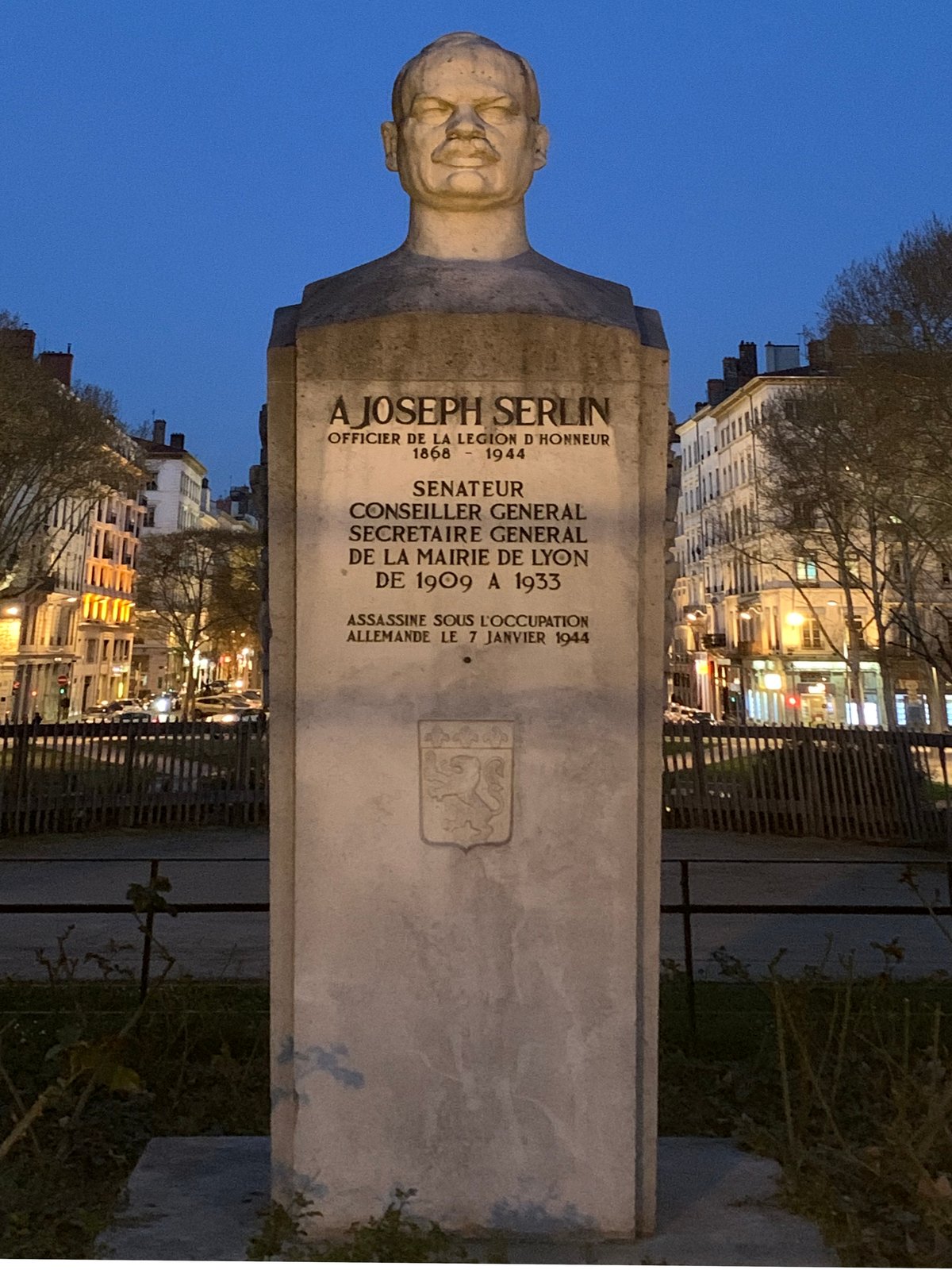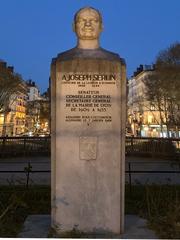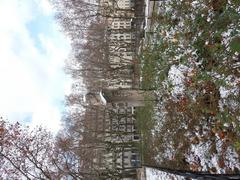
Bust of Joseph Serlin, Lyon, France: Visiting Hours, Tickets, and Historical Information
Date: 14/06/2025
Introduction to the Bust of Joseph Serlin in Lyon
Lyon, celebrated for its deep historical roots and vibrant cultural heritage, invites visitors to discover monuments that reflect its resilient spirit. Among its most significant commemorative sites is the Bust of Joseph Serlin—a tribute to a politician and French Resistance hero whose life and sacrifice are closely linked with Lyon’s identity. Joseph Serlin (1868–1944) played a vital role in Lyon’s municipal administration and in the local Resistance during World War II, ultimately paying the ultimate price for his commitment to liberty and democracy. The bust, situated in Place Maréchal Lyautey in Lyon’s 6th arrondissement, stands as both an individual memorial and a symbol of the city’s broader struggle against oppression.
This guide provides a detailed overview of the monument’s history, artistic features, and cultural significance, along with practical information on visiting, accessibility, and nearby attractions. Whether you are a history enthusiast or a traveler seeking to understand Lyon’s layered past, this article will help you plan a thoughtful visit to the Bust of Joseph Serlin. (UNESCO World Heritage Centre, Lyon Tourism Office, ExploraLyon)
Table of Contents
- Introduction
- Historical Background of Joseph Serlin
- Monument Location and Urban Context
- Artistic Description and Symbolism
- Visiting Information: Hours, Access, and Tickets
- Nearby Attractions and Travel Tips
- Cultural and Community Relevance
- Preservation and Heritage Status
- Frequently Asked Questions (FAQ)
- Conclusion and Visitor Summary
- References
Historical Background of Joseph Serlin
Joseph Serlin was born in 1868 in Crachier, Isère, to a farming family (ExploraLyon). His modest beginnings shaped his character and work ethic. After serving in the military and working as a notary’s clerk, Serlin joined the Lyon city administration, eventually becoming Secretary General of City Hall in 1909, thanks to the support of Mayor Edouard Herriot. He was responsible for personnel, elections, public hygiene, and security, and he played a significant role in organizing events like the 1920 Lyon Fair.
During World War I, Serlin managed Lyon’s food supply under challenging conditions. After retiring from Lyon’s administration, he served as mayor of Crachier and was elected Senator for Isère in 1932, participating in several key parliamentary commissions.
With the onset of World War II, Serlin’s political journey took a momentous turn. Although he initially voted to grant full powers to Marshal Pétain in 1940, he later became actively involved in the French Resistance. He used his administrative expertise to support clandestine efforts, notably distributing ration cards to young men fleeing forced labor. Serlin’s arrest and execution by the Gestapo in 1944 marked him as a martyr and an enduring symbol of resistance in Lyon (ExploraLyon, UNESCO World Heritage Centre).
Monument Location and Urban Context
The Bust of Joseph Serlin is prominently located in Place Maréchal Lyautey in Lyon’s distinguished 6th arrondissement. This square is known for its elegant Haussmannian architecture, tree-lined avenues, and proximity to the Rhône River. The monument stands in a tranquil yet central area that is easily accessible on foot or via public transportation.
Nearby, Rue Joseph Serlin—also named in his honor—reinforces his legacy within the city’s urban fabric (Rues de Lyon). The 6th arrondissement is characterized by wide boulevards, classic architecture, and green spaces like Parc de la Tête d’Or, making it an attractive destination for both locals and visitors. The bust’s location places it within walking distance of major civic and cultural landmarks, including Hôtel de Ville, Opéra de Lyon, and Musée des Beaux-Arts (The Crazy Tourist).
Artistic Description and Symbolism
The bust is a bronze sculpture depicting Joseph Serlin in a reflective pose, with finely rendered facial features that exude dignity and resolve. Set atop a stone pedestal inscribed with his name and dates, the monument commands attention without overwhelming its elegant setting. The patina of the bronze, gradually weathered by time, harmonizes with the square’s mature trees and architectural backdrop.
Symbolically, the bust represents not only Serlin’s personal sacrifice but also Lyon’s broader commitment to republican values and resistance against tyranny. Its orientation facing the main thoroughfare ensures high visibility, while its presence in Place Maréchal Lyautey—named after another significant French figure—creates a dialogue across generations about civic virtue and the cost of freedom (Antoine Photos).
Visiting Information: Hours, Access, and Tickets
- Visiting Hours: The Bust of Joseph Serlin is an outdoor monument and is accessible 24/7 year-round. There are no restrictions on visiting hours, though daylight is recommended for optimal viewing and safety.
- Tickets & Admission: There is no entry fee; the monument is free to visit.
- Accessibility: The square and surrounding area are wheelchair accessible, with smooth pavements and curb cuts.
- Public Transport:
- Metro: Cordeliers (Line A) is the nearest station, about a 6-minute walk away (Moovit).
- Bus: Lines C10, C13, C14, C3, and S1 stop nearby.
- Parking: Limited street parking is available, and Vélo’v bike rental stations are close.
- Guided Tours: While not always included in standard itineraries, many walking tours of Lyon’s historical sites can be customized to include the bust. Consult the Lyon Tourism Office for options.
Nearby Attractions and Travel Tips
The monument’s central location makes it easy to incorporate into a broader city itinerary. Notable nearby attractions include:
- Musée des Beaux-Arts de Lyon: Home to extensive fine arts collections.
- Opéra de Lyon: Known for its innovative architecture and cultural programming.
- Hôtel de Ville: Lyon’s historic city hall.
- Parc de la Tête d’Or: One of Europe’s largest urban parks, just a short walk away.
- Place des Terreaux: A lively square with restaurants, shops, and access to public transport.
Travel Tips:
- Visit in spring or early autumn for pleasant weather and beautiful cityscapes.
- Early mornings and late afternoons provide the best light for photography.
- The area is safe and well-patrolled; take standard precautions with valuables.
- Public amenities (restrooms, cafés, shops) are readily available in the vicinity.
Cultural and Community Relevance
The Bust of Joseph Serlin is not just a static memorial; it plays an active role in Lyon’s civic life. It is a focal point for ceremonies on national remembrance days, including May 8th (Victory in Europe Day) and November 11th (Armistice Day), bringing together officials, residents, and school groups (Alliance Française de Lyon). Educational programs often include visits to the monument to teach students about the values of democracy and resistance.
The bust’s prominent position in the city encourages both daily reflection and public engagement, anchoring the collective memory of Lyon’s wartime experiences.
Preservation and Heritage Status
Lyon’s historic center, encompassing Place Maréchal Lyautey, is a designated UNESCO World Heritage Site (UNESCO World Heritage Centre). The bust is maintained by the city’s cultural heritage department, which ensures its regular cleaning and conservation. On rare occasions, the monument has been subject to vandalism, but restoration efforts are swift, reflecting the community’s respect for Serlin’s legacy (LyonMag).
Frequently Asked Questions (FAQ)
Q: What are the visiting hours for the Bust of Joseph Serlin?
A: The monument is accessible 24/7, with no restrictions.
Q: Is there an admission fee or ticket required?
A: No, visiting the bust is free.
Q: How do I get there by public transport?
A: The nearest Metro station is Cordeliers (Line A). Several bus lines also stop nearby.
Q: Is the site wheelchair accessible?
A: Yes, the area is fully accessible, with smooth pathways.
Q: Are there guided tours that include the bust?
A: Yes, guided walking tours can be arranged through the Lyon Tourism Office.
Q: Are there special events at the monument?
A: The bust is a focal point for commemorations on French national remembrance days and other civic events.
Conclusion and Visitor Summary
The Bust of Joseph Serlin is an essential stop for anyone seeking to understand Lyon’s history, civic values, and enduring spirit. Freely accessible and situated in the elegant 6th arrondissement, it offers a meaningful experience for visitors, whether as a site of reflection, a point of historical interest, or part of a broader exploration of Lyon’s monuments and landmarks.
To enhance your visit, consider joining a guided tour, exploring nearby attractions, and using resources like the Audiala app for up-to-date information and audio guides. The monument stands as a testament to the resilience and values of Lyon’s citizens—inviting all visitors to reflect on the ongoing importance of civic courage and memory.
References and Further Reading
- UNESCO World Heritage Centre
- Lyon Tourism Office
- ExploraLyon
- Antoine Photos
- The Crazy Tourist
- Rues de Lyon
- Centre d’Histoire de la Résistance et de la Déportation
- LyonMag
- Alliance Française de Lyon

































































